Imagination and Mental Imagery in PHI6670 Mind and Language Seminar
VerifiedAdded on 2023/03/30
|17
|4835
|426
Essay
AI Summary
This essay delves into the concepts of imagination and mental imagery, exploring their definitions and the intricate relationship between them. It examines how imagination, defined as the ability to simulate novel objects and ideas without sensory input, interacts with mental imagery, which represents quasi-perceptual experiences. The essay discusses the role of imagination in problem-solving, knowledge application, and the integration of experience. It further analyzes the connections between imagination, mental imagery, and memory, highlighting how they are interconnected within the brain. The essay also touches on the influence of psychological factors on mental processing and the role of imagination in everyday life, including its potential for both pleasure and suffering. Overall, the essay provides a comprehensive overview of imagination and mental imagery, emphasizing their significance in human cognition and experience.
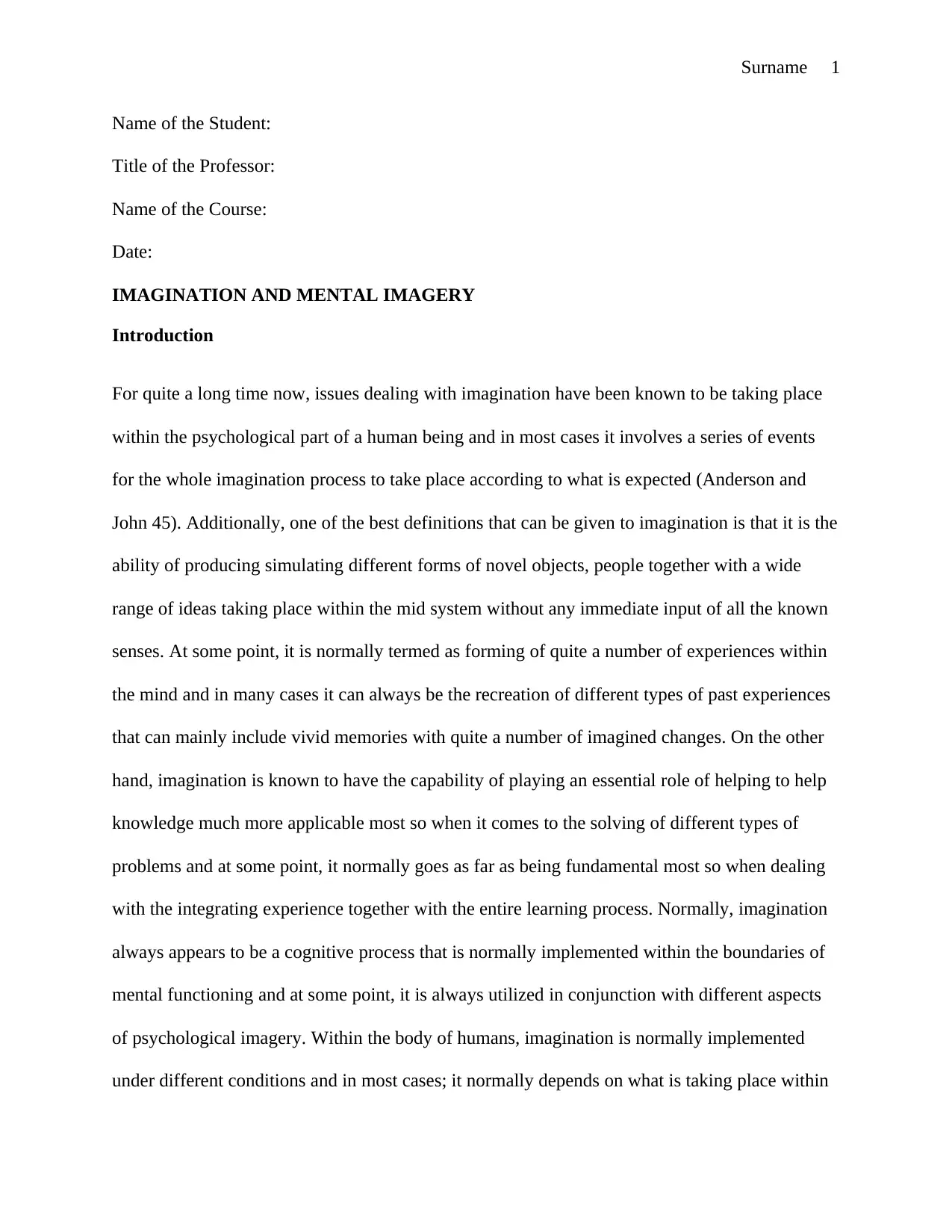
Surname 1
Name of the Student:
Title of the Professor:
Name of the Course:
Date:
IMAGINATION AND MENTAL IMAGERY
Introduction
For quite a long time now, issues dealing with imagination have been known to be taking place
within the psychological part of a human being and in most cases it involves a series of events
for the whole imagination process to take place according to what is expected (Anderson and
John 45). Additionally, one of the best definitions that can be given to imagination is that it is the
ability of producing simulating different forms of novel objects, people together with a wide
range of ideas taking place within the mid system without any immediate input of all the known
senses. At some point, it is normally termed as forming of quite a number of experiences within
the mind and in many cases it can always be the recreation of different types of past experiences
that can mainly include vivid memories with quite a number of imagined changes. On the other
hand, imagination is known to have the capability of playing an essential role of helping to help
knowledge much more applicable most so when it comes to the solving of different types of
problems and at some point, it normally goes as far as being fundamental most so when dealing
with the integrating experience together with the entire learning process. Normally, imagination
always appears to be a cognitive process that is normally implemented within the boundaries of
mental functioning and at some point, it is always utilized in conjunction with different aspects
of psychological imagery. Within the body of humans, imagination is normally implemented
under different conditions and in most cases; it normally depends on what is taking place within
Name of the Student:
Title of the Professor:
Name of the Course:
Date:
IMAGINATION AND MENTAL IMAGERY
Introduction
For quite a long time now, issues dealing with imagination have been known to be taking place
within the psychological part of a human being and in most cases it involves a series of events
for the whole imagination process to take place according to what is expected (Anderson and
John 45). Additionally, one of the best definitions that can be given to imagination is that it is the
ability of producing simulating different forms of novel objects, people together with a wide
range of ideas taking place within the mid system without any immediate input of all the known
senses. At some point, it is normally termed as forming of quite a number of experiences within
the mind and in many cases it can always be the recreation of different types of past experiences
that can mainly include vivid memories with quite a number of imagined changes. On the other
hand, imagination is known to have the capability of playing an essential role of helping to help
knowledge much more applicable most so when it comes to the solving of different types of
problems and at some point, it normally goes as far as being fundamental most so when dealing
with the integrating experience together with the entire learning process. Normally, imagination
always appears to be a cognitive process that is normally implemented within the boundaries of
mental functioning and at some point, it is always utilized in conjunction with different aspects
of psychological imagery. Within the body of humans, imagination is normally implemented
under different conditions and in most cases; it normally depends on what is taking place within
Paraphrase This Document
Need a fresh take? Get an instant paraphrase of this document with our AI Paraphraser
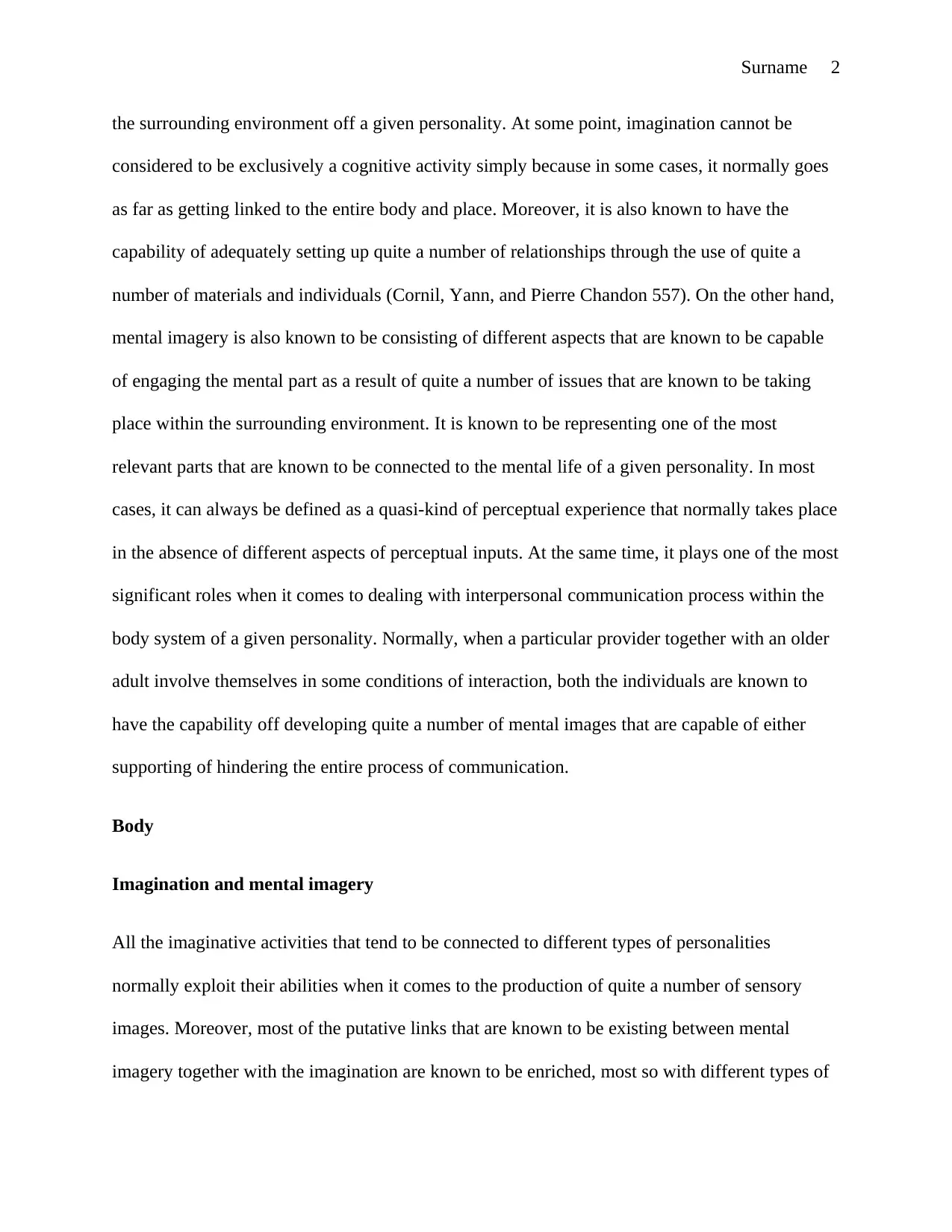
Surname 2
the surrounding environment off a given personality. At some point, imagination cannot be
considered to be exclusively a cognitive activity simply because in some cases, it normally goes
as far as getting linked to the entire body and place. Moreover, it is also known to have the
capability of adequately setting up quite a number of relationships through the use of quite a
number of materials and individuals (Cornil, Yann, and Pierre Chandon 557). On the other hand,
mental imagery is also known to be consisting of different aspects that are known to be capable
of engaging the mental part as a result of quite a number of issues that are known to be taking
place within the surrounding environment. It is known to be representing one of the most
relevant parts that are known to be connected to the mental life of a given personality. In most
cases, it can always be defined as a quasi-kind of perceptual experience that normally takes place
in the absence of different aspects of perceptual inputs. At the same time, it plays one of the most
significant roles when it comes to dealing with interpersonal communication process within the
body system of a given personality. Normally, when a particular provider together with an older
adult involve themselves in some conditions of interaction, both the individuals are known to
have the capability off developing quite a number of mental images that are capable of either
supporting of hindering the entire process of communication.
Body
Imagination and mental imagery
All the imaginative activities that tend to be connected to different types of personalities
normally exploit their abilities when it comes to the production of quite a number of sensory
images. Moreover, most of the putative links that are known to be existing between mental
imagery together with the imagination are known to be enriched, most so with different types of
the surrounding environment off a given personality. At some point, imagination cannot be
considered to be exclusively a cognitive activity simply because in some cases, it normally goes
as far as getting linked to the entire body and place. Moreover, it is also known to have the
capability of adequately setting up quite a number of relationships through the use of quite a
number of materials and individuals (Cornil, Yann, and Pierre Chandon 557). On the other hand,
mental imagery is also known to be consisting of different aspects that are known to be capable
of engaging the mental part as a result of quite a number of issues that are known to be taking
place within the surrounding environment. It is known to be representing one of the most
relevant parts that are known to be connected to the mental life of a given personality. In most
cases, it can always be defined as a quasi-kind of perceptual experience that normally takes place
in the absence of different aspects of perceptual inputs. At the same time, it plays one of the most
significant roles when it comes to dealing with interpersonal communication process within the
body system of a given personality. Normally, when a particular provider together with an older
adult involve themselves in some conditions of interaction, both the individuals are known to
have the capability off developing quite a number of mental images that are capable of either
supporting of hindering the entire process of communication.
Body
Imagination and mental imagery
All the imaginative activities that tend to be connected to different types of personalities
normally exploit their abilities when it comes to the production of quite a number of sensory
images. Moreover, most of the putative links that are known to be existing between mental
imagery together with the imagination are known to be enriched, most so with different types of
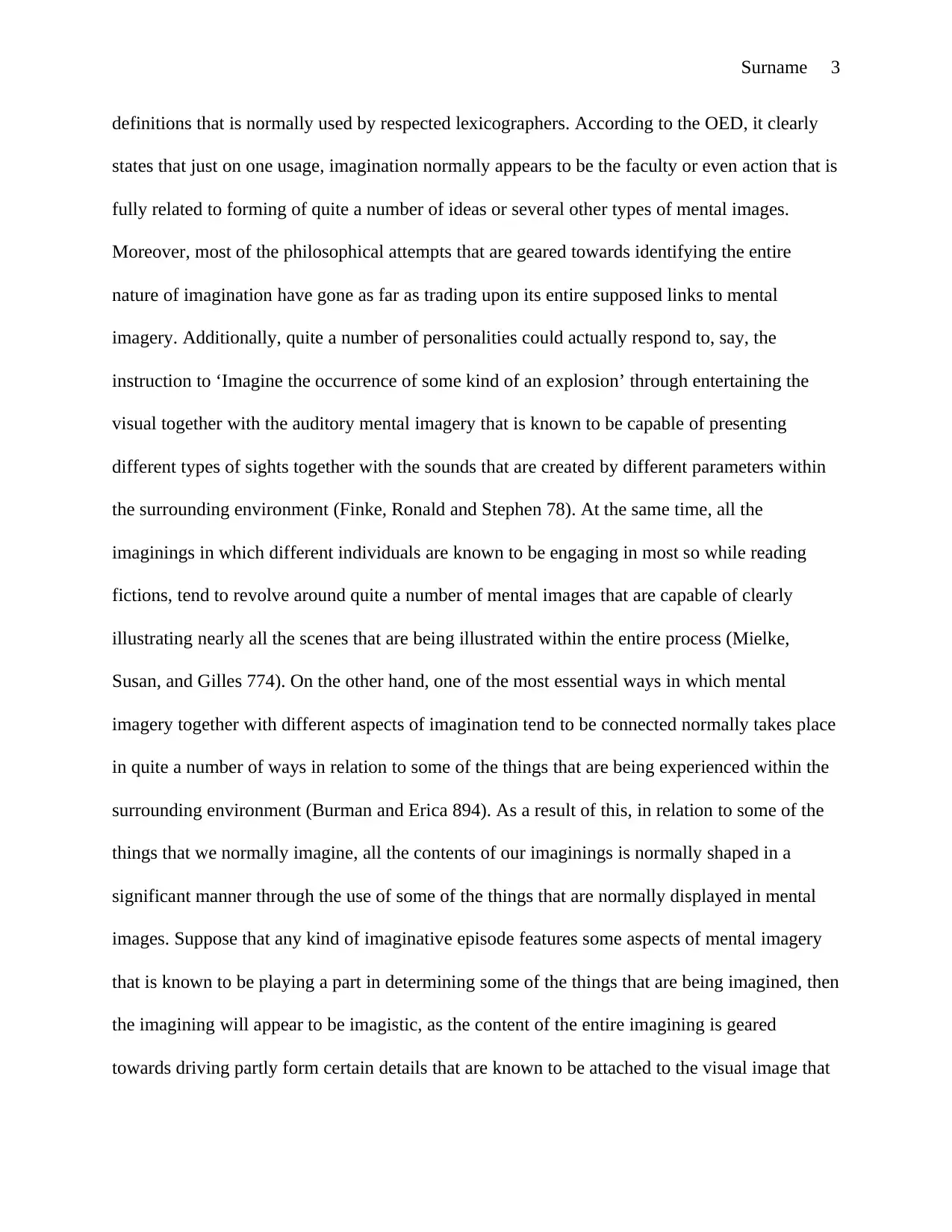
Surname 3
definitions that is normally used by respected lexicographers. According to the OED, it clearly
states that just on one usage, imagination normally appears to be the faculty or even action that is
fully related to forming of quite a number of ideas or several other types of mental images.
Moreover, most of the philosophical attempts that are geared towards identifying the entire
nature of imagination have gone as far as trading upon its entire supposed links to mental
imagery. Additionally, quite a number of personalities could actually respond to, say, the
instruction to ‘Imagine the occurrence of some kind of an explosion’ through entertaining the
visual together with the auditory mental imagery that is known to be capable of presenting
different types of sights together with the sounds that are created by different parameters within
the surrounding environment (Finke, Ronald and Stephen 78). At the same time, all the
imaginings in which different individuals are known to be engaging in most so while reading
fictions, tend to revolve around quite a number of mental images that are capable of clearly
illustrating nearly all the scenes that are being illustrated within the entire process (Mielke,
Susan, and Gilles 774). On the other hand, one of the most essential ways in which mental
imagery together with different aspects of imagination tend to be connected normally takes place
in quite a number of ways in relation to some of the things that are being experienced within the
surrounding environment (Burman and Erica 894). As a result of this, in relation to some of the
things that we normally imagine, all the contents of our imaginings is normally shaped in a
significant manner through the use of some of the things that are normally displayed in mental
images. Suppose that any kind of imaginative episode features some aspects of mental imagery
that is known to be playing a part in determining some of the things that are being imagined, then
the imagining will appear to be imagistic, as the content of the entire imagining is geared
towards driving partly form certain details that are known to be attached to the visual image that
definitions that is normally used by respected lexicographers. According to the OED, it clearly
states that just on one usage, imagination normally appears to be the faculty or even action that is
fully related to forming of quite a number of ideas or several other types of mental images.
Moreover, most of the philosophical attempts that are geared towards identifying the entire
nature of imagination have gone as far as trading upon its entire supposed links to mental
imagery. Additionally, quite a number of personalities could actually respond to, say, the
instruction to ‘Imagine the occurrence of some kind of an explosion’ through entertaining the
visual together with the auditory mental imagery that is known to be capable of presenting
different types of sights together with the sounds that are created by different parameters within
the surrounding environment (Finke, Ronald and Stephen 78). At the same time, all the
imaginings in which different individuals are known to be engaging in most so while reading
fictions, tend to revolve around quite a number of mental images that are capable of clearly
illustrating nearly all the scenes that are being illustrated within the entire process (Mielke,
Susan, and Gilles 774). On the other hand, one of the most essential ways in which mental
imagery together with different aspects of imagination tend to be connected normally takes place
in quite a number of ways in relation to some of the things that are being experienced within the
surrounding environment (Burman and Erica 894). As a result of this, in relation to some of the
things that we normally imagine, all the contents of our imaginings is normally shaped in a
significant manner through the use of some of the things that are normally displayed in mental
images. Suppose that any kind of imaginative episode features some aspects of mental imagery
that is known to be playing a part in determining some of the things that are being imagined, then
the imagining will appear to be imagistic, as the content of the entire imagining is geared
towards driving partly form certain details that are known to be attached to the visual image that
⊘ This is a preview!⊘
Do you want full access?
Subscribe today to unlock all pages.

Trusted by 1+ million students worldwide
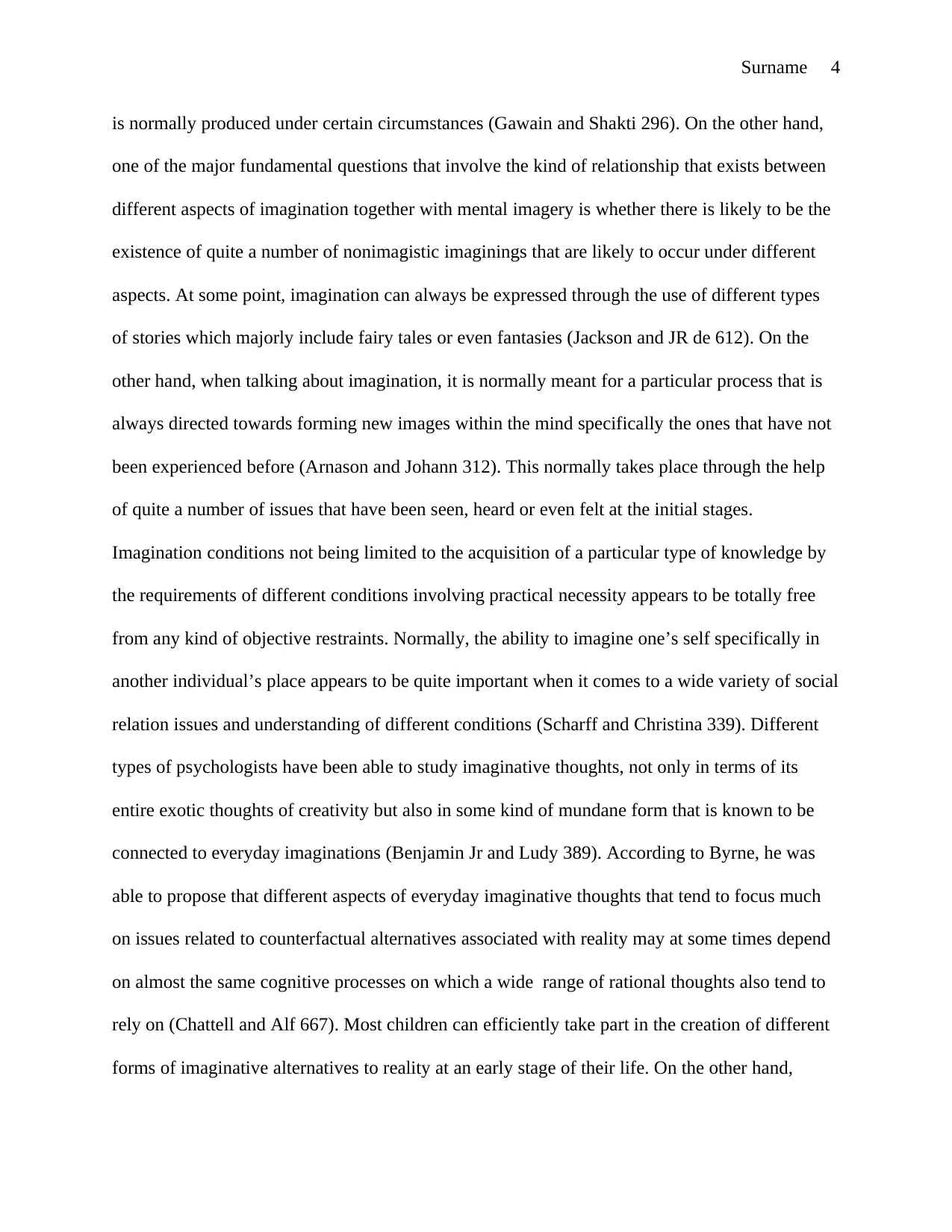
Surname 4
is normally produced under certain circumstances (Gawain and Shakti 296). On the other hand,
one of the major fundamental questions that involve the kind of relationship that exists between
different aspects of imagination together with mental imagery is whether there is likely to be the
existence of quite a number of nonimagistic imaginings that are likely to occur under different
aspects. At some point, imagination can always be expressed through the use of different types
of stories which majorly include fairy tales or even fantasies (Jackson and JR de 612). On the
other hand, when talking about imagination, it is normally meant for a particular process that is
always directed towards forming new images within the mind specifically the ones that have not
been experienced before (Arnason and Johann 312). This normally takes place through the help
of quite a number of issues that have been seen, heard or even felt at the initial stages.
Imagination conditions not being limited to the acquisition of a particular type of knowledge by
the requirements of different conditions involving practical necessity appears to be totally free
from any kind of objective restraints. Normally, the ability to imagine one’s self specifically in
another individual’s place appears to be quite important when it comes to a wide variety of social
relation issues and understanding of different conditions (Scharff and Christina 339). Different
types of psychologists have been able to study imaginative thoughts, not only in terms of its
entire exotic thoughts of creativity but also in some kind of mundane form that is known to be
connected to everyday imaginations (Benjamin Jr and Ludy 389). According to Byrne, he was
able to propose that different aspects of everyday imaginative thoughts that tend to focus much
on issues related to counterfactual alternatives associated with reality may at some times depend
on almost the same cognitive processes on which a wide range of rational thoughts also tend to
rely on (Chattell and Alf 667). Most children can efficiently take part in the creation of different
forms of imaginative alternatives to reality at an early stage of their life. On the other hand,
is normally produced under certain circumstances (Gawain and Shakti 296). On the other hand,
one of the major fundamental questions that involve the kind of relationship that exists between
different aspects of imagination together with mental imagery is whether there is likely to be the
existence of quite a number of nonimagistic imaginings that are likely to occur under different
aspects. At some point, imagination can always be expressed through the use of different types
of stories which majorly include fairy tales or even fantasies (Jackson and JR de 612). On the
other hand, when talking about imagination, it is normally meant for a particular process that is
always directed towards forming new images within the mind specifically the ones that have not
been experienced before (Arnason and Johann 312). This normally takes place through the help
of quite a number of issues that have been seen, heard or even felt at the initial stages.
Imagination conditions not being limited to the acquisition of a particular type of knowledge by
the requirements of different conditions involving practical necessity appears to be totally free
from any kind of objective restraints. Normally, the ability to imagine one’s self specifically in
another individual’s place appears to be quite important when it comes to a wide variety of social
relation issues and understanding of different conditions (Scharff and Christina 339). Different
types of psychologists have been able to study imaginative thoughts, not only in terms of its
entire exotic thoughts of creativity but also in some kind of mundane form that is known to be
connected to everyday imaginations (Benjamin Jr and Ludy 389). According to Byrne, he was
able to propose that different aspects of everyday imaginative thoughts that tend to focus much
on issues related to counterfactual alternatives associated with reality may at some times depend
on almost the same cognitive processes on which a wide range of rational thoughts also tend to
rely on (Chattell and Alf 667). Most children can efficiently take part in the creation of different
forms of imaginative alternatives to reality at an early stage of their life. On the other hand,
Paraphrase This Document
Need a fresh take? Get an instant paraphrase of this document with our AI Paraphraser
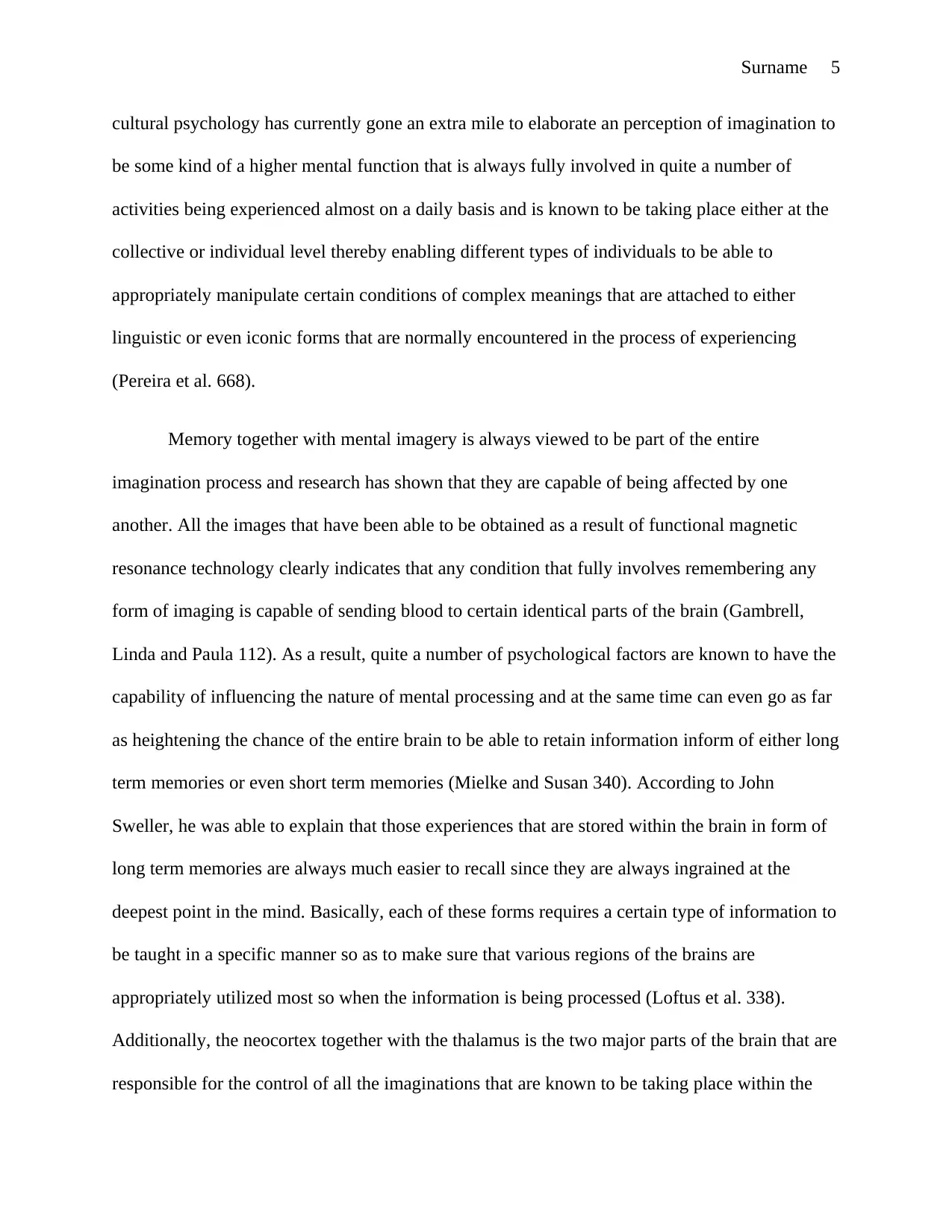
Surname 5
cultural psychology has currently gone an extra mile to elaborate an perception of imagination to
be some kind of a higher mental function that is always fully involved in quite a number of
activities being experienced almost on a daily basis and is known to be taking place either at the
collective or individual level thereby enabling different types of individuals to be able to
appropriately manipulate certain conditions of complex meanings that are attached to either
linguistic or even iconic forms that are normally encountered in the process of experiencing
(Pereira et al. 668).
Memory together with mental imagery is always viewed to be part of the entire
imagination process and research has shown that they are capable of being affected by one
another. All the images that have been able to be obtained as a result of functional magnetic
resonance technology clearly indicates that any condition that fully involves remembering any
form of imaging is capable of sending blood to certain identical parts of the brain (Gambrell,
Linda and Paula 112). As a result, quite a number of psychological factors are known to have the
capability of influencing the nature of mental processing and at the same time can even go as far
as heightening the chance of the entire brain to be able to retain information inform of either long
term memories or even short term memories (Mielke and Susan 340). According to John
Sweller, he was able to explain that those experiences that are stored within the brain in form of
long term memories are always much easier to recall since they are always ingrained at the
deepest point in the mind. Basically, each of these forms requires a certain type of information to
be taught in a specific manner so as to make sure that various regions of the brains are
appropriately utilized most so when the information is being processed (Loftus et al. 338).
Additionally, the neocortex together with the thalamus is the two major parts of the brain that are
responsible for the control of all the imaginations that are known to be taking place within the
cultural psychology has currently gone an extra mile to elaborate an perception of imagination to
be some kind of a higher mental function that is always fully involved in quite a number of
activities being experienced almost on a daily basis and is known to be taking place either at the
collective or individual level thereby enabling different types of individuals to be able to
appropriately manipulate certain conditions of complex meanings that are attached to either
linguistic or even iconic forms that are normally encountered in the process of experiencing
(Pereira et al. 668).
Memory together with mental imagery is always viewed to be part of the entire
imagination process and research has shown that they are capable of being affected by one
another. All the images that have been able to be obtained as a result of functional magnetic
resonance technology clearly indicates that any condition that fully involves remembering any
form of imaging is capable of sending blood to certain identical parts of the brain (Gambrell,
Linda and Paula 112). As a result, quite a number of psychological factors are known to have the
capability of influencing the nature of mental processing and at the same time can even go as far
as heightening the chance of the entire brain to be able to retain information inform of either long
term memories or even short term memories (Mielke and Susan 340). According to John
Sweller, he was able to explain that those experiences that are stored within the brain in form of
long term memories are always much easier to recall since they are always ingrained at the
deepest point in the mind. Basically, each of these forms requires a certain type of information to
be taught in a specific manner so as to make sure that various regions of the brains are
appropriately utilized most so when the information is being processed (Loftus et al. 338).
Additionally, the neocortex together with the thalamus is the two major parts of the brain that are
responsible for the control of all the imaginations that are known to be taking place within the
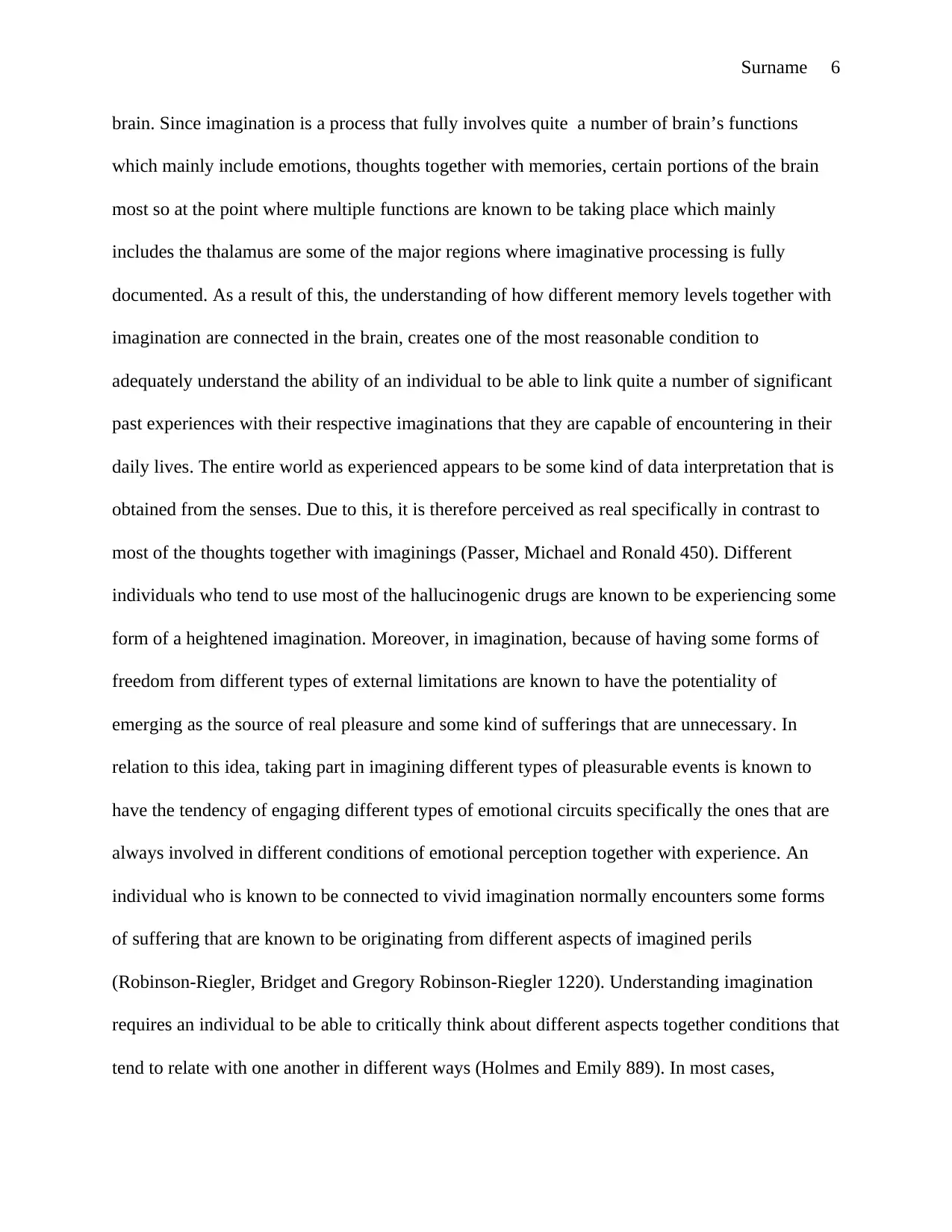
Surname 6
brain. Since imagination is a process that fully involves quite a number of brain’s functions
which mainly include emotions, thoughts together with memories, certain portions of the brain
most so at the point where multiple functions are known to be taking place which mainly
includes the thalamus are some of the major regions where imaginative processing is fully
documented. As a result of this, the understanding of how different memory levels together with
imagination are connected in the brain, creates one of the most reasonable condition to
adequately understand the ability of an individual to be able to link quite a number of significant
past experiences with their respective imaginations that they are capable of encountering in their
daily lives. The entire world as experienced appears to be some kind of data interpretation that is
obtained from the senses. Due to this, it is therefore perceived as real specifically in contrast to
most of the thoughts together with imaginings (Passer, Michael and Ronald 450). Different
individuals who tend to use most of the hallucinogenic drugs are known to be experiencing some
form of a heightened imagination. Moreover, in imagination, because of having some forms of
freedom from different types of external limitations are known to have the potentiality of
emerging as the source of real pleasure and some kind of sufferings that are unnecessary. In
relation to this idea, taking part in imagining different types of pleasurable events is known to
have the tendency of engaging different types of emotional circuits specifically the ones that are
always involved in different conditions of emotional perception together with experience. An
individual who is known to be connected to vivid imagination normally encounters some forms
of suffering that are known to be originating from different aspects of imagined perils
(Robinson-Riegler, Bridget and Gregory Robinson-Riegler 1220). Understanding imagination
requires an individual to be able to critically think about different aspects together conditions that
tend to relate with one another in different ways (Holmes and Emily 889). In most cases,
brain. Since imagination is a process that fully involves quite a number of brain’s functions
which mainly include emotions, thoughts together with memories, certain portions of the brain
most so at the point where multiple functions are known to be taking place which mainly
includes the thalamus are some of the major regions where imaginative processing is fully
documented. As a result of this, the understanding of how different memory levels together with
imagination are connected in the brain, creates one of the most reasonable condition to
adequately understand the ability of an individual to be able to link quite a number of significant
past experiences with their respective imaginations that they are capable of encountering in their
daily lives. The entire world as experienced appears to be some kind of data interpretation that is
obtained from the senses. Due to this, it is therefore perceived as real specifically in contrast to
most of the thoughts together with imaginings (Passer, Michael and Ronald 450). Different
individuals who tend to use most of the hallucinogenic drugs are known to be experiencing some
form of a heightened imagination. Moreover, in imagination, because of having some forms of
freedom from different types of external limitations are known to have the potentiality of
emerging as the source of real pleasure and some kind of sufferings that are unnecessary. In
relation to this idea, taking part in imagining different types of pleasurable events is known to
have the tendency of engaging different types of emotional circuits specifically the ones that are
always involved in different conditions of emotional perception together with experience. An
individual who is known to be connected to vivid imagination normally encounters some forms
of suffering that are known to be originating from different aspects of imagined perils
(Robinson-Riegler, Bridget and Gregory Robinson-Riegler 1220). Understanding imagination
requires an individual to be able to critically think about different aspects together conditions that
tend to relate with one another in different ways (Holmes and Emily 889). In most cases,
⊘ This is a preview!⊘
Do you want full access?
Subscribe today to unlock all pages.

Trusted by 1+ million students worldwide
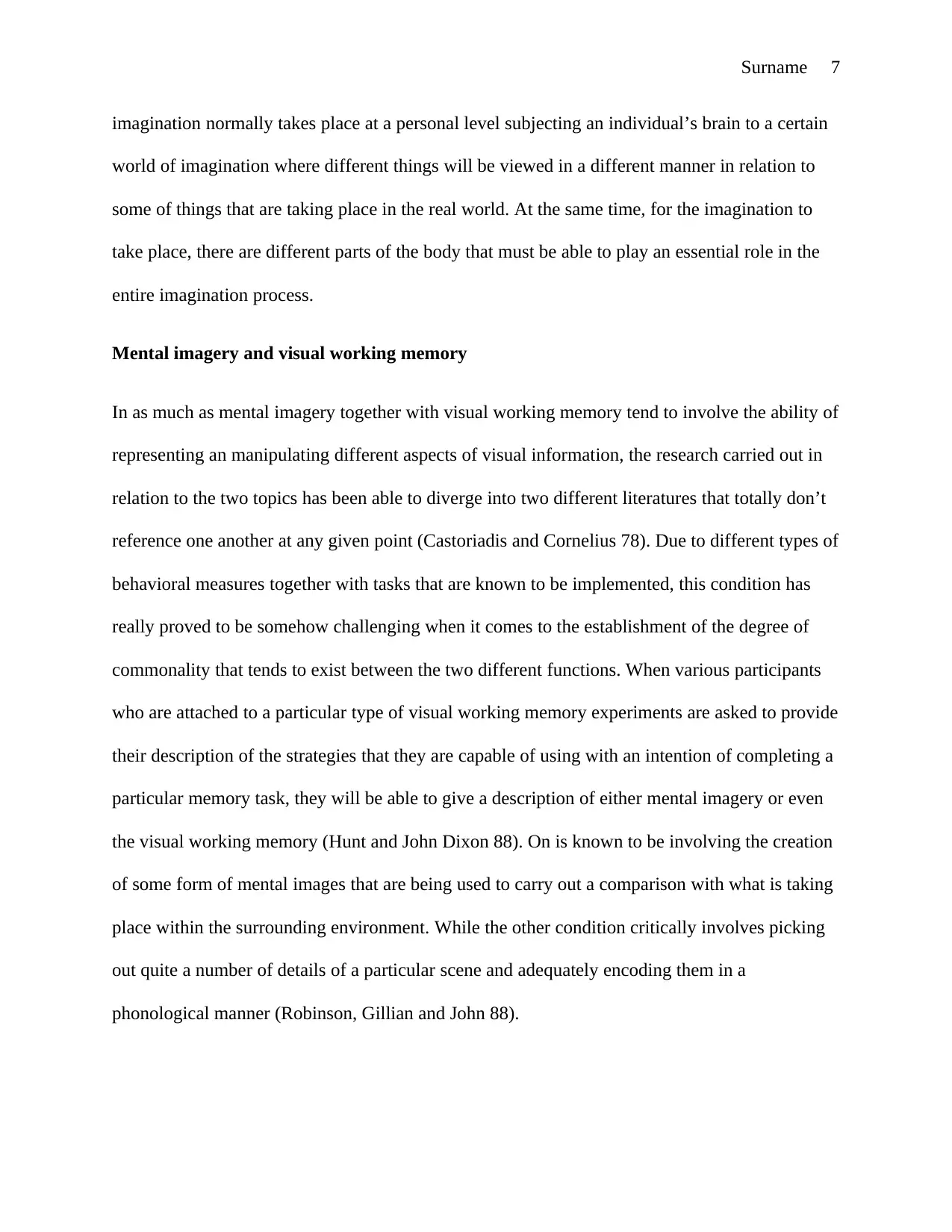
Surname 7
imagination normally takes place at a personal level subjecting an individual’s brain to a certain
world of imagination where different things will be viewed in a different manner in relation to
some of things that are taking place in the real world. At the same time, for the imagination to
take place, there are different parts of the body that must be able to play an essential role in the
entire imagination process.
Mental imagery and visual working memory
In as much as mental imagery together with visual working memory tend to involve the ability of
representing an manipulating different aspects of visual information, the research carried out in
relation to the two topics has been able to diverge into two different literatures that totally don’t
reference one another at any given point (Castoriadis and Cornelius 78). Due to different types of
behavioral measures together with tasks that are known to be implemented, this condition has
really proved to be somehow challenging when it comes to the establishment of the degree of
commonality that tends to exist between the two different functions. When various participants
who are attached to a particular type of visual working memory experiments are asked to provide
their description of the strategies that they are capable of using with an intention of completing a
particular memory task, they will be able to give a description of either mental imagery or even
the visual working memory (Hunt and John Dixon 88). On is known to be involving the creation
of some form of mental images that are being used to carry out a comparison with what is taking
place within the surrounding environment. While the other condition critically involves picking
out quite a number of details of a particular scene and adequately encoding them in a
phonological manner (Robinson, Gillian and John 88).
imagination normally takes place at a personal level subjecting an individual’s brain to a certain
world of imagination where different things will be viewed in a different manner in relation to
some of things that are taking place in the real world. At the same time, for the imagination to
take place, there are different parts of the body that must be able to play an essential role in the
entire imagination process.
Mental imagery and visual working memory
In as much as mental imagery together with visual working memory tend to involve the ability of
representing an manipulating different aspects of visual information, the research carried out in
relation to the two topics has been able to diverge into two different literatures that totally don’t
reference one another at any given point (Castoriadis and Cornelius 78). Due to different types of
behavioral measures together with tasks that are known to be implemented, this condition has
really proved to be somehow challenging when it comes to the establishment of the degree of
commonality that tends to exist between the two different functions. When various participants
who are attached to a particular type of visual working memory experiments are asked to provide
their description of the strategies that they are capable of using with an intention of completing a
particular memory task, they will be able to give a description of either mental imagery or even
the visual working memory (Hunt and John Dixon 88). On is known to be involving the creation
of some form of mental images that are being used to carry out a comparison with what is taking
place within the surrounding environment. While the other condition critically involves picking
out quite a number of details of a particular scene and adequately encoding them in a
phonological manner (Robinson, Gillian and John 88).
Paraphrase This Document
Need a fresh take? Get an instant paraphrase of this document with our AI Paraphraser
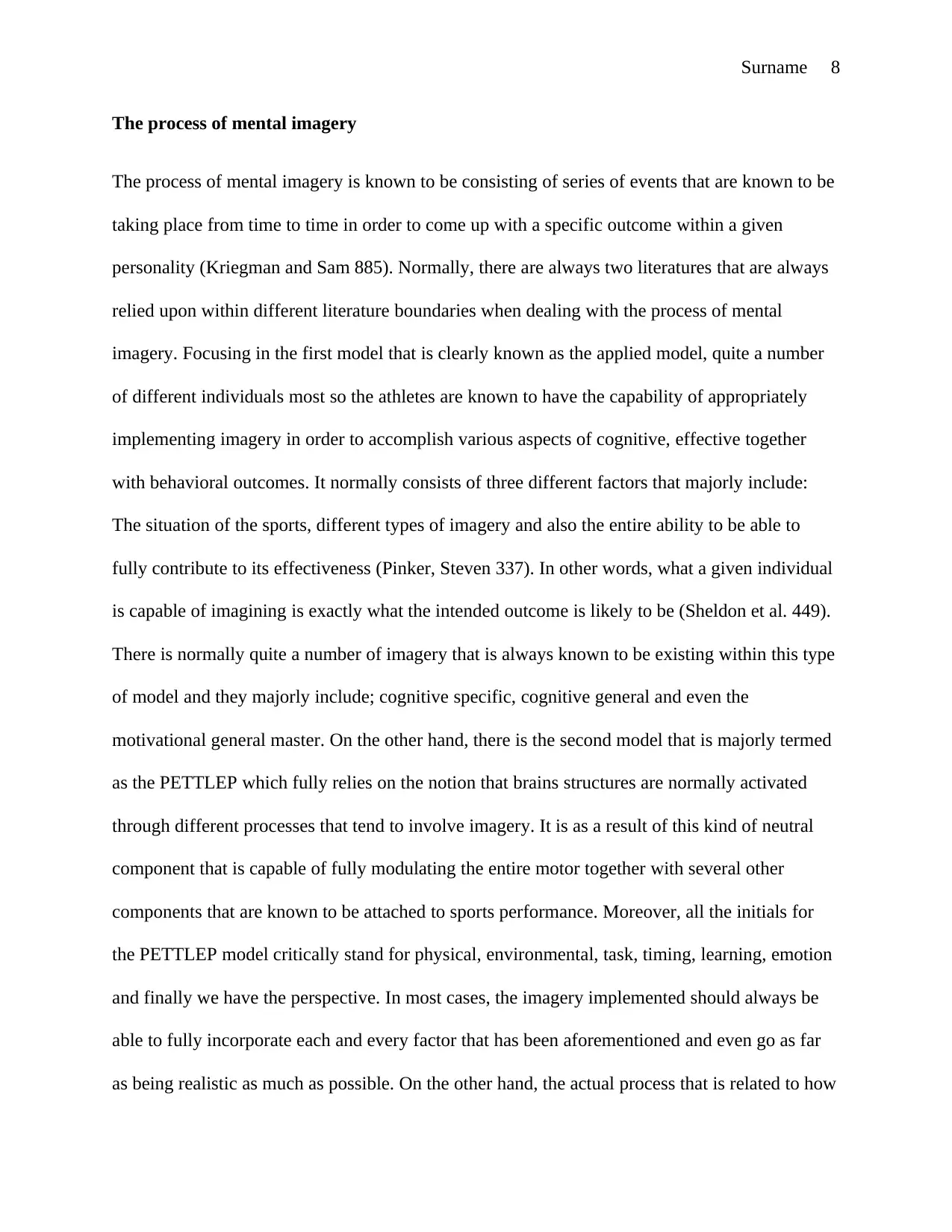
Surname 8
The process of mental imagery
The process of mental imagery is known to be consisting of series of events that are known to be
taking place from time to time in order to come up with a specific outcome within a given
personality (Kriegman and Sam 885). Normally, there are always two literatures that are always
relied upon within different literature boundaries when dealing with the process of mental
imagery. Focusing in the first model that is clearly known as the applied model, quite a number
of different individuals most so the athletes are known to have the capability of appropriately
implementing imagery in order to accomplish various aspects of cognitive, effective together
with behavioral outcomes. It normally consists of three different factors that majorly include:
The situation of the sports, different types of imagery and also the entire ability to be able to
fully contribute to its effectiveness (Pinker, Steven 337). In other words, what a given individual
is capable of imagining is exactly what the intended outcome is likely to be (Sheldon et al. 449).
There is normally quite a number of imagery that is always known to be existing within this type
of model and they majorly include; cognitive specific, cognitive general and even the
motivational general master. On the other hand, there is the second model that is majorly termed
as the PETTLEP which fully relies on the notion that brains structures are normally activated
through different processes that tend to involve imagery. It is as a result of this kind of neutral
component that is capable of fully modulating the entire motor together with several other
components that are known to be attached to sports performance. Moreover, all the initials for
the PETTLEP model critically stand for physical, environmental, task, timing, learning, emotion
and finally we have the perspective. In most cases, the imagery implemented should always be
able to fully incorporate each and every factor that has been aforementioned and even go as far
as being realistic as much as possible. On the other hand, the actual process that is related to how
The process of mental imagery
The process of mental imagery is known to be consisting of series of events that are known to be
taking place from time to time in order to come up with a specific outcome within a given
personality (Kriegman and Sam 885). Normally, there are always two literatures that are always
relied upon within different literature boundaries when dealing with the process of mental
imagery. Focusing in the first model that is clearly known as the applied model, quite a number
of different individuals most so the athletes are known to have the capability of appropriately
implementing imagery in order to accomplish various aspects of cognitive, effective together
with behavioral outcomes. It normally consists of three different factors that majorly include:
The situation of the sports, different types of imagery and also the entire ability to be able to
fully contribute to its effectiveness (Pinker, Steven 337). In other words, what a given individual
is capable of imagining is exactly what the intended outcome is likely to be (Sheldon et al. 449).
There is normally quite a number of imagery that is always known to be existing within this type
of model and they majorly include; cognitive specific, cognitive general and even the
motivational general master. On the other hand, there is the second model that is majorly termed
as the PETTLEP which fully relies on the notion that brains structures are normally activated
through different processes that tend to involve imagery. It is as a result of this kind of neutral
component that is capable of fully modulating the entire motor together with several other
components that are known to be attached to sports performance. Moreover, all the initials for
the PETTLEP model critically stand for physical, environmental, task, timing, learning, emotion
and finally we have the perspective. In most cases, the imagery implemented should always be
able to fully incorporate each and every factor that has been aforementioned and even go as far
as being realistic as much as possible. On the other hand, the actual process that is related to how
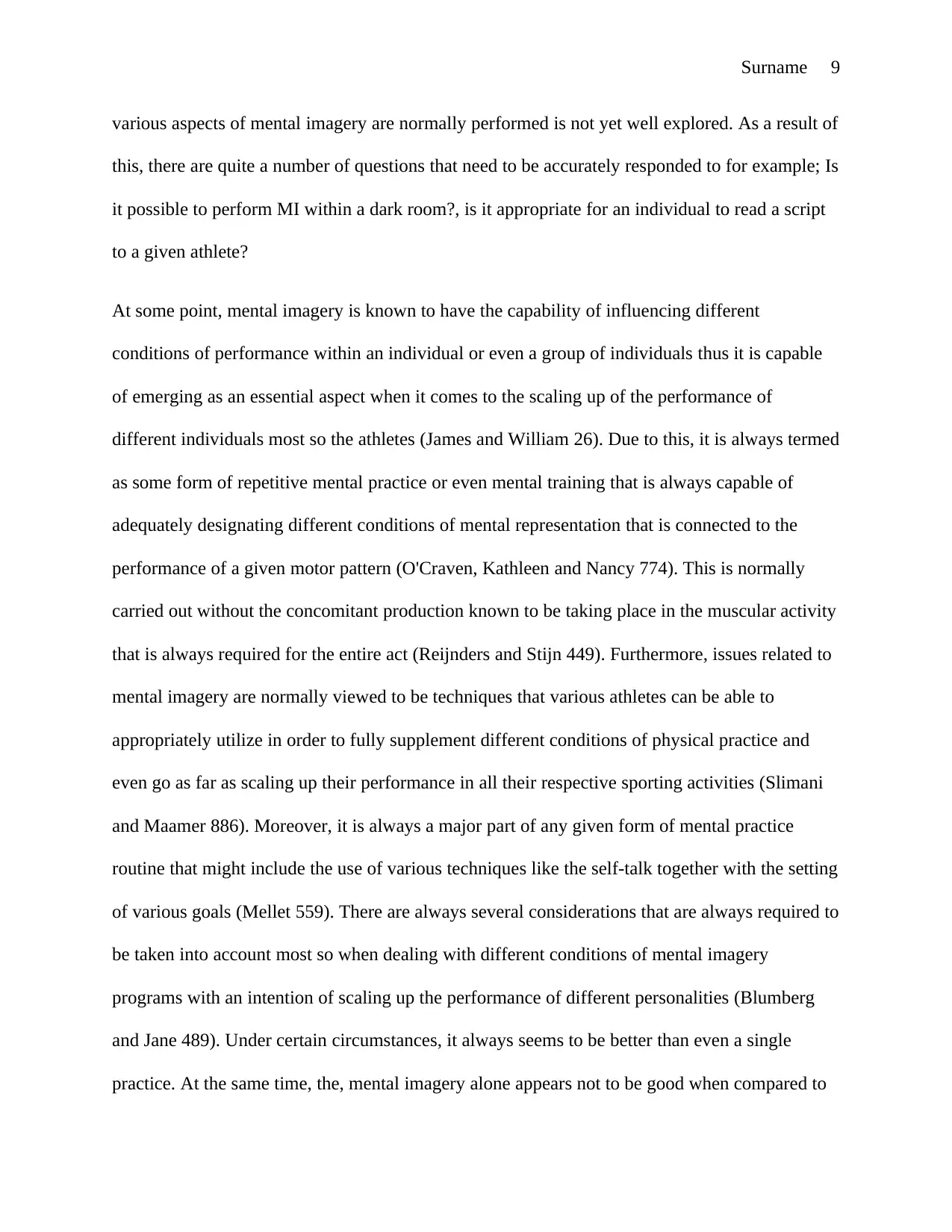
Surname 9
various aspects of mental imagery are normally performed is not yet well explored. As a result of
this, there are quite a number of questions that need to be accurately responded to for example; Is
it possible to perform MI within a dark room?, is it appropriate for an individual to read a script
to a given athlete?
At some point, mental imagery is known to have the capability of influencing different
conditions of performance within an individual or even a group of individuals thus it is capable
of emerging as an essential aspect when it comes to the scaling up of the performance of
different individuals most so the athletes (James and William 26). Due to this, it is always termed
as some form of repetitive mental practice or even mental training that is always capable of
adequately designating different conditions of mental representation that is connected to the
performance of a given motor pattern (O'Craven, Kathleen and Nancy 774). This is normally
carried out without the concomitant production known to be taking place in the muscular activity
that is always required for the entire act (Reijnders and Stijn 449). Furthermore, issues related to
mental imagery are normally viewed to be techniques that various athletes can be able to
appropriately utilize in order to fully supplement different conditions of physical practice and
even go as far as scaling up their performance in all their respective sporting activities (Slimani
and Maamer 886). Moreover, it is always a major part of any given form of mental practice
routine that might include the use of various techniques like the self-talk together with the setting
of various goals (Mellet 559). There are always several considerations that are always required to
be taken into account most so when dealing with different conditions of mental imagery
programs with an intention of scaling up the performance of different personalities (Blumberg
and Jane 489). Under certain circumstances, it always seems to be better than even a single
practice. At the same time, the, mental imagery alone appears not to be good when compared to
various aspects of mental imagery are normally performed is not yet well explored. As a result of
this, there are quite a number of questions that need to be accurately responded to for example; Is
it possible to perform MI within a dark room?, is it appropriate for an individual to read a script
to a given athlete?
At some point, mental imagery is known to have the capability of influencing different
conditions of performance within an individual or even a group of individuals thus it is capable
of emerging as an essential aspect when it comes to the scaling up of the performance of
different individuals most so the athletes (James and William 26). Due to this, it is always termed
as some form of repetitive mental practice or even mental training that is always capable of
adequately designating different conditions of mental representation that is connected to the
performance of a given motor pattern (O'Craven, Kathleen and Nancy 774). This is normally
carried out without the concomitant production known to be taking place in the muscular activity
that is always required for the entire act (Reijnders and Stijn 449). Furthermore, issues related to
mental imagery are normally viewed to be techniques that various athletes can be able to
appropriately utilize in order to fully supplement different conditions of physical practice and
even go as far as scaling up their performance in all their respective sporting activities (Slimani
and Maamer 886). Moreover, it is always a major part of any given form of mental practice
routine that might include the use of various techniques like the self-talk together with the setting
of various goals (Mellet 559). There are always several considerations that are always required to
be taken into account most so when dealing with different conditions of mental imagery
programs with an intention of scaling up the performance of different personalities (Blumberg
and Jane 489). Under certain circumstances, it always seems to be better than even a single
practice. At the same time, the, mental imagery alone appears not to be good when compared to
⊘ This is a preview!⊘
Do you want full access?
Subscribe today to unlock all pages.

Trusted by 1+ million students worldwide
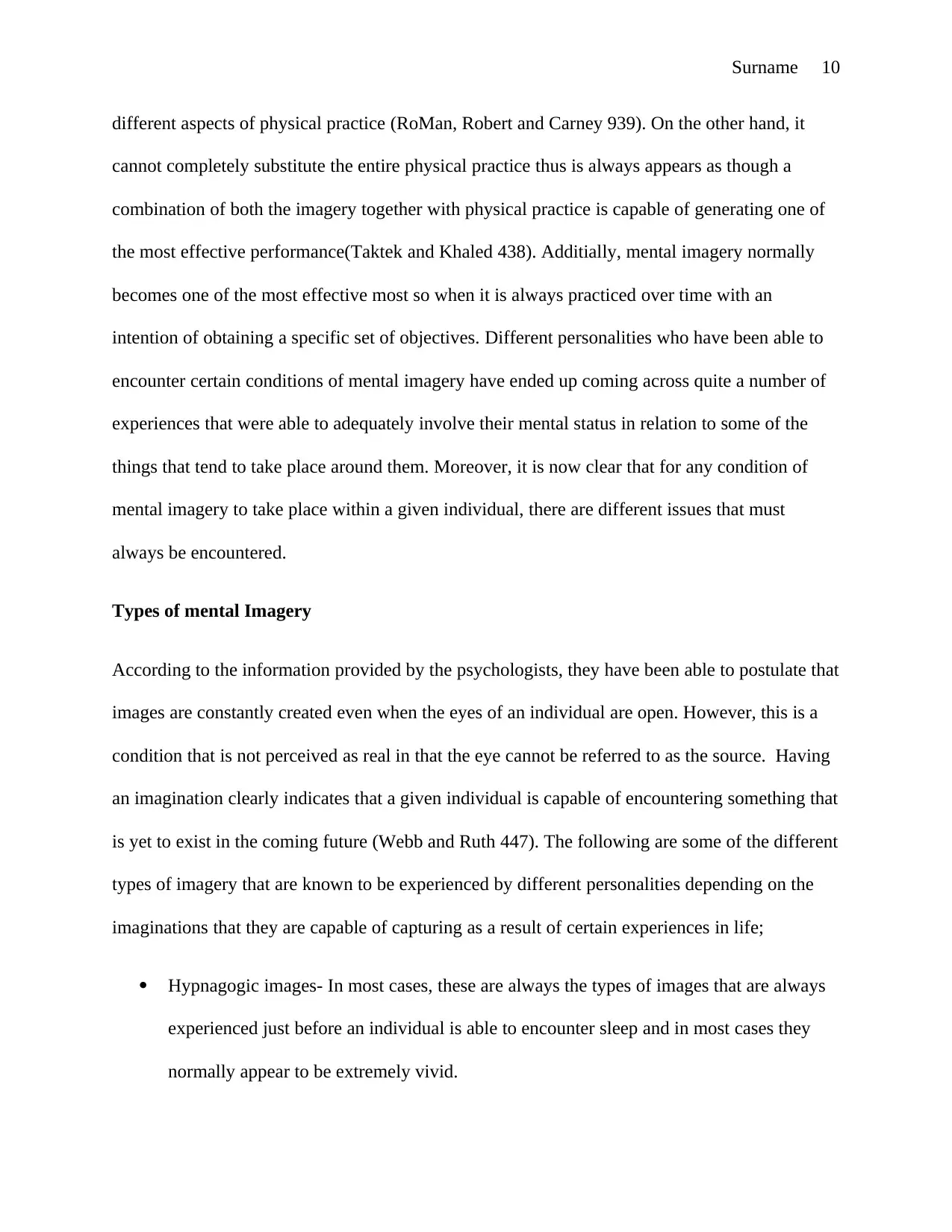
Surname 10
different aspects of physical practice (RoMan, Robert and Carney 939). On the other hand, it
cannot completely substitute the entire physical practice thus is always appears as though a
combination of both the imagery together with physical practice is capable of generating one of
the most effective performance(Taktek and Khaled 438). Additially, mental imagery normally
becomes one of the most effective most so when it is always practiced over time with an
intention of obtaining a specific set of objectives. Different personalities who have been able to
encounter certain conditions of mental imagery have ended up coming across quite a number of
experiences that were able to adequately involve their mental status in relation to some of the
things that tend to take place around them. Moreover, it is now clear that for any condition of
mental imagery to take place within a given individual, there are different issues that must
always be encountered.
Types of mental Imagery
According to the information provided by the psychologists, they have been able to postulate that
images are constantly created even when the eyes of an individual are open. However, this is a
condition that is not perceived as real in that the eye cannot be referred to as the source. Having
an imagination clearly indicates that a given individual is capable of encountering something that
is yet to exist in the coming future (Webb and Ruth 447). The following are some of the different
types of imagery that are known to be experienced by different personalities depending on the
imaginations that they are capable of capturing as a result of certain experiences in life;
Hypnagogic images- In most cases, these are always the types of images that are always
experienced just before an individual is able to encounter sleep and in most cases they
normally appear to be extremely vivid.
different aspects of physical practice (RoMan, Robert and Carney 939). On the other hand, it
cannot completely substitute the entire physical practice thus is always appears as though a
combination of both the imagery together with physical practice is capable of generating one of
the most effective performance(Taktek and Khaled 438). Additially, mental imagery normally
becomes one of the most effective most so when it is always practiced over time with an
intention of obtaining a specific set of objectives. Different personalities who have been able to
encounter certain conditions of mental imagery have ended up coming across quite a number of
experiences that were able to adequately involve their mental status in relation to some of the
things that tend to take place around them. Moreover, it is now clear that for any condition of
mental imagery to take place within a given individual, there are different issues that must
always be encountered.
Types of mental Imagery
According to the information provided by the psychologists, they have been able to postulate that
images are constantly created even when the eyes of an individual are open. However, this is a
condition that is not perceived as real in that the eye cannot be referred to as the source. Having
an imagination clearly indicates that a given individual is capable of encountering something that
is yet to exist in the coming future (Webb and Ruth 447). The following are some of the different
types of imagery that are known to be experienced by different personalities depending on the
imaginations that they are capable of capturing as a result of certain experiences in life;
Hypnagogic images- In most cases, these are always the types of images that are always
experienced just before an individual is able to encounter sleep and in most cases they
normally appear to be extremely vivid.
Paraphrase This Document
Need a fresh take? Get an instant paraphrase of this document with our AI Paraphraser
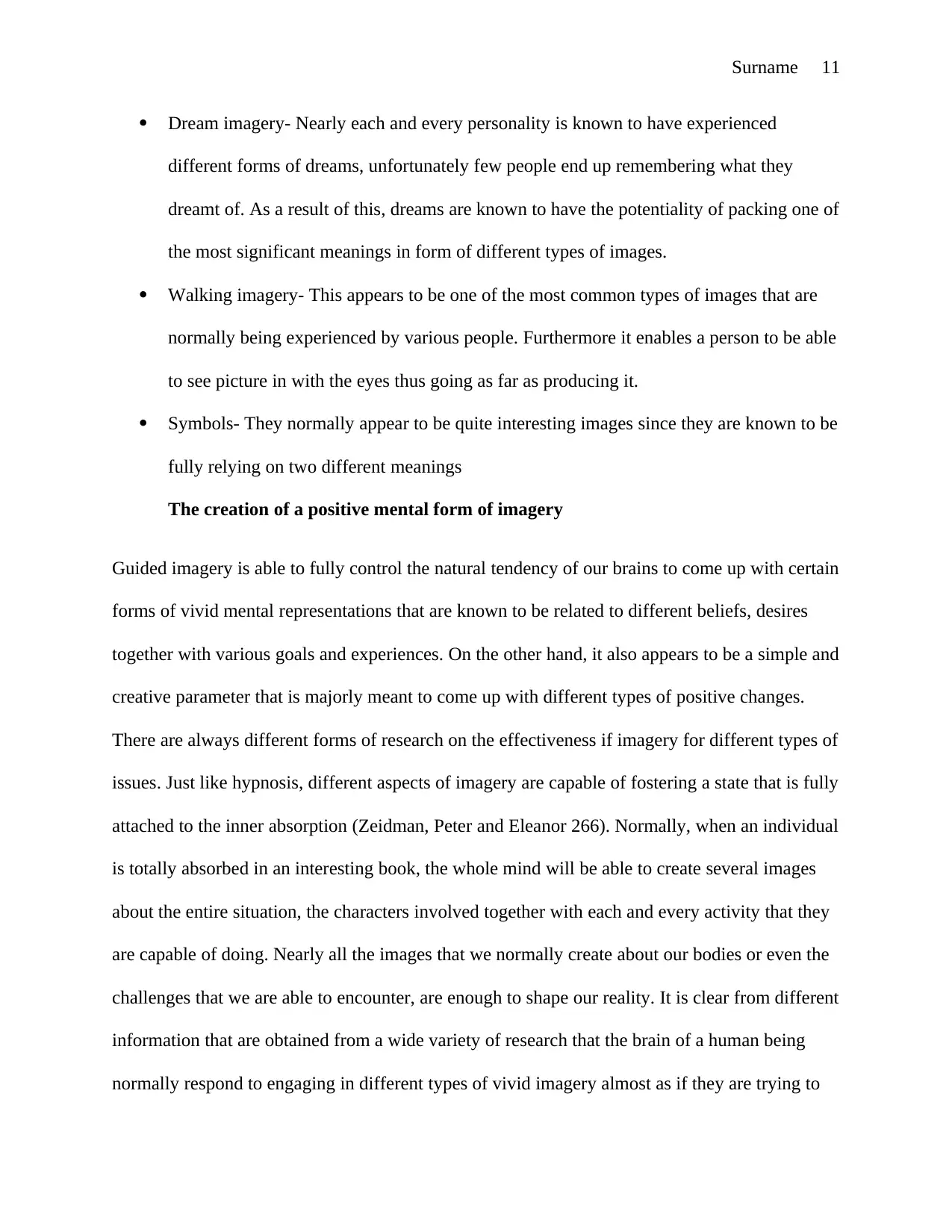
Surname 11
Dream imagery- Nearly each and every personality is known to have experienced
different forms of dreams, unfortunately few people end up remembering what they
dreamt of. As a result of this, dreams are known to have the potentiality of packing one of
the most significant meanings in form of different types of images.
Walking imagery- This appears to be one of the most common types of images that are
normally being experienced by various people. Furthermore it enables a person to be able
to see picture in with the eyes thus going as far as producing it.
Symbols- They normally appear to be quite interesting images since they are known to be
fully relying on two different meanings
The creation of a positive mental form of imagery
Guided imagery is able to fully control the natural tendency of our brains to come up with certain
forms of vivid mental representations that are known to be related to different beliefs, desires
together with various goals and experiences. On the other hand, it also appears to be a simple and
creative parameter that is majorly meant to come up with different types of positive changes.
There are always different forms of research on the effectiveness if imagery for different types of
issues. Just like hypnosis, different aspects of imagery are capable of fostering a state that is fully
attached to the inner absorption (Zeidman, Peter and Eleanor 266). Normally, when an individual
is totally absorbed in an interesting book, the whole mind will be able to create several images
about the entire situation, the characters involved together with each and every activity that they
are capable of doing. Nearly all the images that we normally create about our bodies or even the
challenges that we are able to encounter, are enough to shape our reality. It is clear from different
information that are obtained from a wide variety of research that the brain of a human being
normally respond to engaging in different types of vivid imagery almost as if they are trying to
Dream imagery- Nearly each and every personality is known to have experienced
different forms of dreams, unfortunately few people end up remembering what they
dreamt of. As a result of this, dreams are known to have the potentiality of packing one of
the most significant meanings in form of different types of images.
Walking imagery- This appears to be one of the most common types of images that are
normally being experienced by various people. Furthermore it enables a person to be able
to see picture in with the eyes thus going as far as producing it.
Symbols- They normally appear to be quite interesting images since they are known to be
fully relying on two different meanings
The creation of a positive mental form of imagery
Guided imagery is able to fully control the natural tendency of our brains to come up with certain
forms of vivid mental representations that are known to be related to different beliefs, desires
together with various goals and experiences. On the other hand, it also appears to be a simple and
creative parameter that is majorly meant to come up with different types of positive changes.
There are always different forms of research on the effectiveness if imagery for different types of
issues. Just like hypnosis, different aspects of imagery are capable of fostering a state that is fully
attached to the inner absorption (Zeidman, Peter and Eleanor 266). Normally, when an individual
is totally absorbed in an interesting book, the whole mind will be able to create several images
about the entire situation, the characters involved together with each and every activity that they
are capable of doing. Nearly all the images that we normally create about our bodies or even the
challenges that we are able to encounter, are enough to shape our reality. It is clear from different
information that are obtained from a wide variety of research that the brain of a human being
normally respond to engaging in different types of vivid imagery almost as if they are trying to
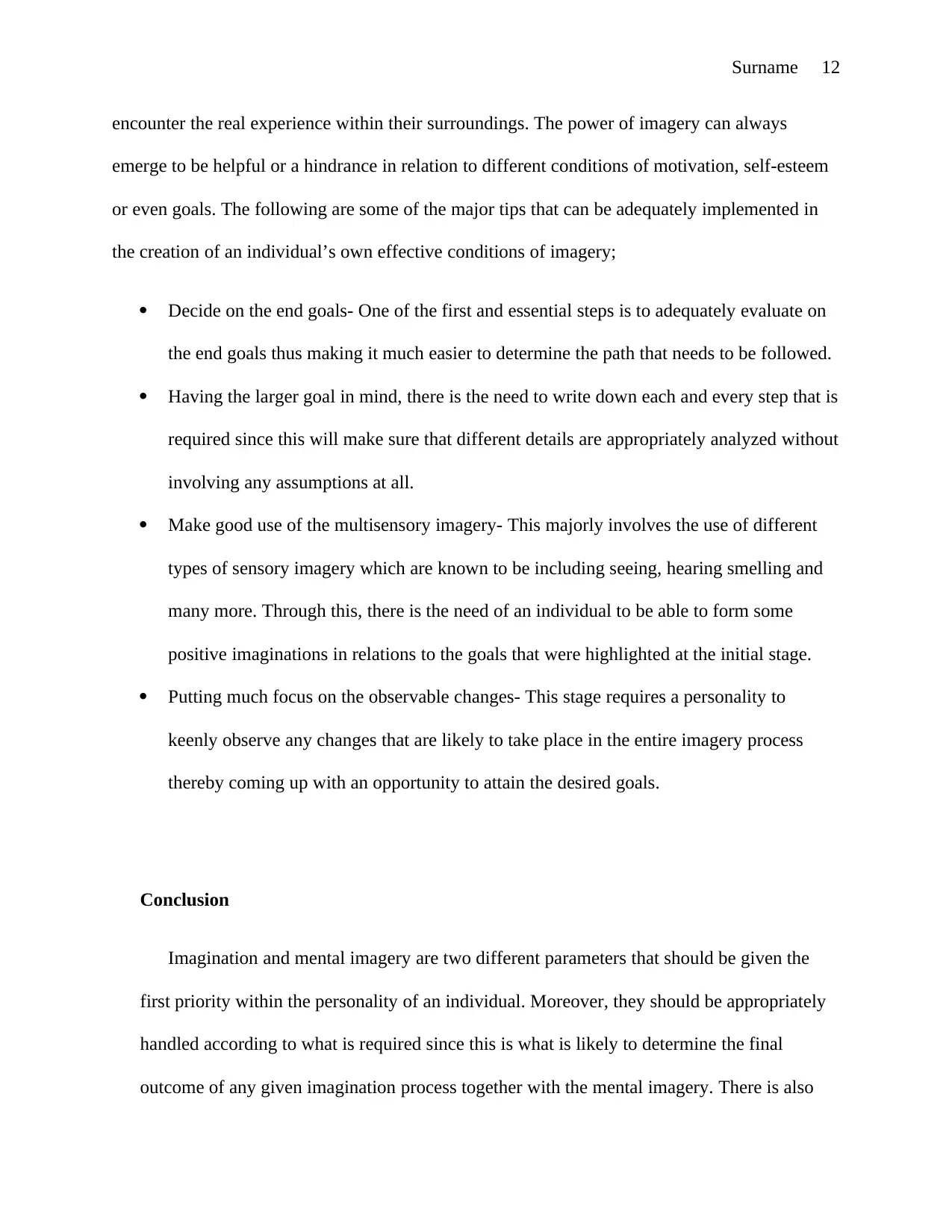
Surname 12
encounter the real experience within their surroundings. The power of imagery can always
emerge to be helpful or a hindrance in relation to different conditions of motivation, self-esteem
or even goals. The following are some of the major tips that can be adequately implemented in
the creation of an individual’s own effective conditions of imagery;
Decide on the end goals- One of the first and essential steps is to adequately evaluate on
the end goals thus making it much easier to determine the path that needs to be followed.
Having the larger goal in mind, there is the need to write down each and every step that is
required since this will make sure that different details are appropriately analyzed without
involving any assumptions at all.
Make good use of the multisensory imagery- This majorly involves the use of different
types of sensory imagery which are known to be including seeing, hearing smelling and
many more. Through this, there is the need of an individual to be able to form some
positive imaginations in relations to the goals that were highlighted at the initial stage.
Putting much focus on the observable changes- This stage requires a personality to
keenly observe any changes that are likely to take place in the entire imagery process
thereby coming up with an opportunity to attain the desired goals.
Conclusion
Imagination and mental imagery are two different parameters that should be given the
first priority within the personality of an individual. Moreover, they should be appropriately
handled according to what is required since this is what is likely to determine the final
outcome of any given imagination process together with the mental imagery. There is also
encounter the real experience within their surroundings. The power of imagery can always
emerge to be helpful or a hindrance in relation to different conditions of motivation, self-esteem
or even goals. The following are some of the major tips that can be adequately implemented in
the creation of an individual’s own effective conditions of imagery;
Decide on the end goals- One of the first and essential steps is to adequately evaluate on
the end goals thus making it much easier to determine the path that needs to be followed.
Having the larger goal in mind, there is the need to write down each and every step that is
required since this will make sure that different details are appropriately analyzed without
involving any assumptions at all.
Make good use of the multisensory imagery- This majorly involves the use of different
types of sensory imagery which are known to be including seeing, hearing smelling and
many more. Through this, there is the need of an individual to be able to form some
positive imaginations in relations to the goals that were highlighted at the initial stage.
Putting much focus on the observable changes- This stage requires a personality to
keenly observe any changes that are likely to take place in the entire imagery process
thereby coming up with an opportunity to attain the desired goals.
Conclusion
Imagination and mental imagery are two different parameters that should be given the
first priority within the personality of an individual. Moreover, they should be appropriately
handled according to what is required since this is what is likely to determine the final
outcome of any given imagination process together with the mental imagery. There is also
⊘ This is a preview!⊘
Do you want full access?
Subscribe today to unlock all pages.

Trusted by 1+ million students worldwide
1 out of 17
Related Documents
Your All-in-One AI-Powered Toolkit for Academic Success.
+13062052269
info@desklib.com
Available 24*7 on WhatsApp / Email
![[object Object]](/_next/static/media/star-bottom.7253800d.svg)
Unlock your academic potential
Copyright © 2020–2025 A2Z Services. All Rights Reserved. Developed and managed by ZUCOL.





